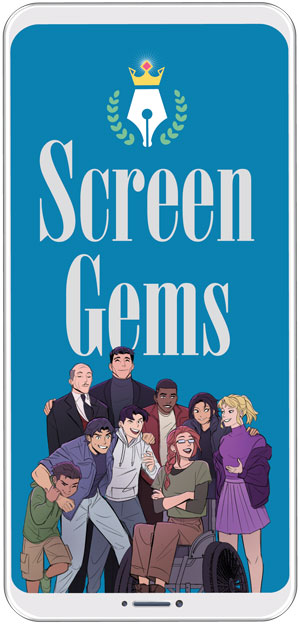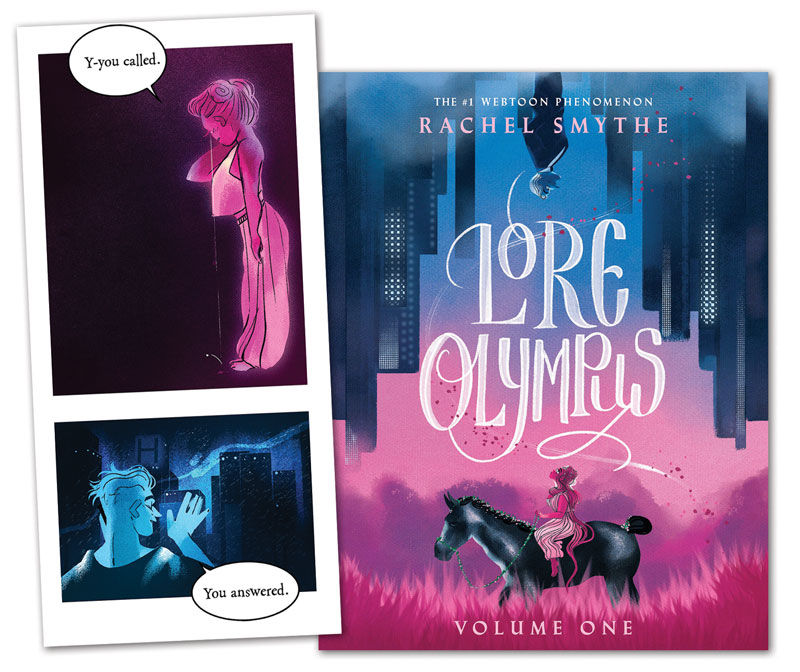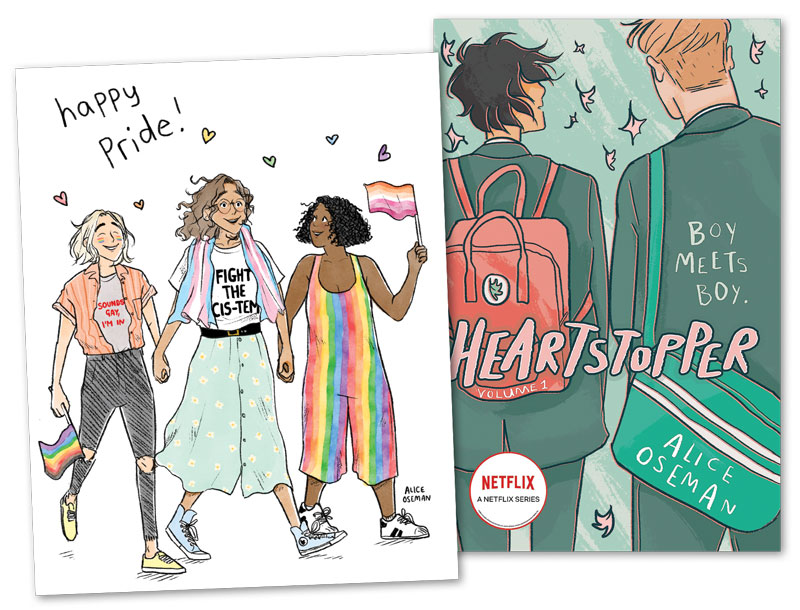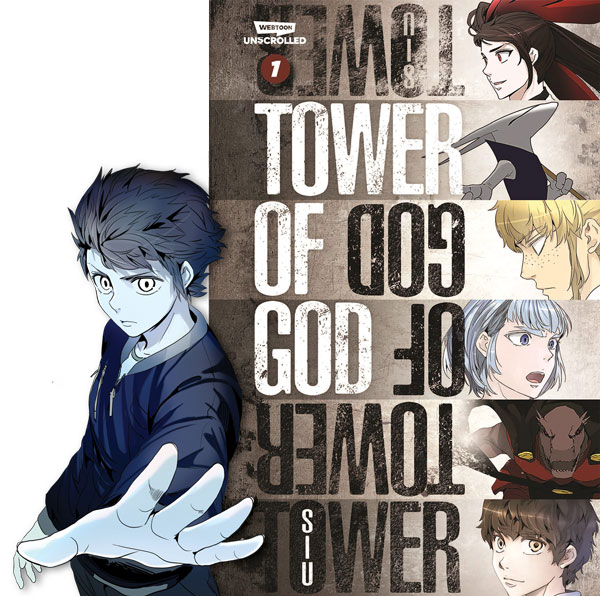Designed for Phones, Webtoons Find a Home in Print
Mostly free and readily available, webtoons are particularly appealing to teens and young adults. Publishers have seized the opportunity to bring many to print.
 |
Phone inset: “Batman: Wayne Family Adventures”by CRC Payne and StarbiteSource for all credited images: WEBTOON |
Related reading: |
Alice Oseman’s teen romance “Heartstopper,” Rachel Smythe’s Greek-gods story “Lore Olympus,” and Chugong’s fantasy action series “Solo Leveling” may not have much in common, but they all have a similar origin story: They built huge audiences as webtoons—comics designed to be read vertically on a smartphone. Mostly free, readily available, and grouped on platforms that make it easy to find and binge on new series, webtoons are particularly appealing to teens and young adults. As their popularity has soared over the past few years, publishers have seized the opportunity to bring many to print. Yen Press’s imprint Ize Press is dedicated to Korean webtoons; Andrews McMeel has signed a publishing deal with the webtoon site Tapas; and Webtoon, the largest online platform, rolled out its own publishing arm, Webtoon Unscrolled, in 2022. In June, Random House launched a new imprint, Inklore, “dedicated to celebrating the most popular, fan-driven tropes in visual storytelling, with a focus on digital-to-print licensed publishing in the romance, fantasy, science fiction, horror, and slice-of-life genres.”
“Fan-driven” is the operative word here. Andrea Lipinski, senior young adult librarian at the Kingsbridge branch of the New York Public Library in the Bronx, found out about webtoons from her teen advisory group, which was putting together a recommended reading/watching list for fans of the game Among Us. “In addition to suggestions for books, movies, and TV shows, my teens also suggested a webtoons list,” she says.
Other librarians confirm popularity of webtoon-based graphic novels, too. “‘Heartstopper’ and ‘Lore Olympus’ are must-buys as new volumes are released,” says Nancy McKay, head of teen services at the Byron, IL, Public Library District.
“The last two volumes of ‘Heartstopper’ have a waitlist, and they’ve been out for a couple of years now,” says Joe Pascullo, YA librarian at the New York Public Library’s 53rd Street branch.
Indeed, “Heartstopper” has a passionate following. “It’s always in my top five of checkouts,” says Nate Hipple, librarian at Burley Middle School in Charlottesville, VA. “We did a big March Madness tournament with the top 32 series that get checked out from the library, and it won in a landslide. I let kids vote multiple times, and in the final match, despite my school being just under 600 kids, ‘Heartstopper’ received thousands of votes.”
Webtoons can be read on a smartphone, tablet, or web browser, but the format works best on smartphones, where one panel at a time appears in the narrow window. Many are continuous, using visual transitions in place of panel borders. Creators use a change in the background color, the appearance of clouds, fluttering leaves, or other visual cues to signal to the reader that a change is about to occur.
While the format is distinctive, the real difference between webtoons and ordinary webcomics is discoverability. Webtoon platforms carry hundreds of series, and the mix leans heavily toward romance, popular with the young female readers who make up most of the audience. Whether they prefer fantasy stories about empresses and villains, contemporary workplace comedies, or LGBTQIA+ romances, fans will find a host of similar titles literally at their fingertips, with one or more new ones being promoted on the platform at any given time.
 |
"Lore Olympus” by Rachel Smythe |
Webtoons 101
The word webtoon is a generic term for vertical-scroll comics, while Webtoon (formerly Line Webtoon) is one of many platforms carrying them. Webtoon and Tapas are the two biggest English-language services; smaller ones include Tappytoon, Manta, Lezhin, and Netcomics.
The concept of webtoons originated in Korea. All the large webtoon platforms have Korean roots and carry titles licensed from Korea, such as “The Remarried Empress” (Webtoon) and “Solo Leveling” (Tapas and Tappytoon). Mixed in with these are vertical-scroll comics by creators from around the world, many of which are creator-owned series uploaded by the users. Webtoon Originals and Tapas Originals webtoons have more internal oversight; the platform is the publisher and owns some of the rights.
Most of the content on webtoon platforms is free, but not all. Users can use in-app currency to unlock individual episodes, get early access, or buy day passes. Manta, which carries manhwa (Korean comics) produced by its own studios, is unique for its subscription model: A monthly fee provides access to all the comics on the app.
Although introduced to the United States in the mid-2010s, webtoons caught fire with American readers in the past three years. Michael Son, vice president of content for Tapas Entertainment, attributes that to the fact that several platforms arrived in North America at once and advertised heavily. “It wasn’t so much that we were competing with one another; it was one of those rising-tide-raises-all-ships-kind of scenarios,” he says. The platforms invested in building a community of creators as well as readers, which has led to a greater variety of stories. “I believe that these stories made comics way more accessible to a younger, more digitally native readership,” Son says.
While print editions of webtoons usually carry age ratings assigned by publishers, it’s less clear-cut on digital platforms. Webtoons don’t usually come with age recommendations, but there are still constraints. “We abide by content policy guidelines set out by the Apple and Google app stores,” says Son, and “we have a well-defined policy that we share with creators.” An internal team reviews stories, and Tapas tags mature ones, requiring readers to have an account and opt in to read them.
 |
Heartstopper by Alice Oseman |
Giving readers what they want
Romance is the fastest-growing webtoon genre, says Tom Akel, co-founder and CEO of Rocketship Entertainment and head of content at Webtoon from 2015 to 2018. Launched in 2019, Rocketship is built largely on webtoon properties, and Akel works with creators to publish their works as print graphic novels. The books are crowdfunded initially and distributed through Simon & Schuster.
Judging from Kickstarter fulfillments and the audience at Rocketship panels, Akel says the readership is largely female and young, ages 16–24. Buyers of print books tend to be slightly older than those who only read webtoons, he says, perhaps because they have more disposable income.
Some of the most popular webtoons are manhwa. The recent surge in interest in K-pop and Korean culture has made readers more receptive to manhwa, but the chief reason for its popularity is that manhwa offers a different approach, says Ernest Woo, co-founder and chief product officer at Tappytoon. “A broader variety of ‘real life’ themes and nuanced depictions of human drama, young adult, and adult emotional growth have been the mainstay of Korean comics,” he says, as opposed to shoujo or shonen/hero-centric manga from the United States or Japan. How webtoons are produced in Korea also makes a difference, he notes: They are published in full color in short, easy-to-absorb episodes and developed as their own properties, not tied to animation or toys, like much manga.
On Tappytoon, whose audience is mostly adult, romance and boys’ love are the most popular genres, followed by action titles such as “Solo Leveling.” At Tapas, action-fantasy, romance-fantasy, modern romance, and slice-of-life stories are top categories.
 |
|
“Tower of God” by SIU |
From smartphones to bookshelves
One of the first webtoons to get traction in print was Stephen McCranie’s “Space Boy,” a middle grade story about a girl adjusting to life after being cryogenically frozen for 30 years. It won a Webtoon competition in 2015 and still runs on the site; Dark Horse has been publishing it in print since 2018.
While manga continues to be the top-selling graphic novel category, webtoon-based graphic novels lead all the rest, with “Heartstopper,” “Lore Olympus,” and “Solo Leveling” consistently topping the graphic novel best seller lists.
Webtoons come to print in a variety of ways. Webtoon Unscrolled launched 2022 with titles such as “True Beauty” and “Tower of God,” but most webtoons still print through existing publishers. Ize Press has a robust catalog with popular titles such as “The Remarried Empress,” “Villains Are Destined to Die,” and “My Gently Raised Beast,” and Yen has picked up non-Korean titles like
TurtleMe’s “The Beginning After the End.”
For Andrews McMeel, which already published compilations of webcomics and newspaper comics, webtoons were a logical next step. “We knew Tapas from several of our authors and started talking to them a few years back. Soon after, we published Fangs by Sarah Andersen,” says Betty Wong, executive editor and director of the book group at Andrews McMeel. Now the company has a deal with Tapas to publish some Tapas Original titles. “Knowing that these stories have passionate fandoms online also gives us confidence that they will appeal to a wider book audience as well,” Wong says.
Andrews McMeel’s first three Tapas titles are all YA: “Unfamiliar,” a slice-of-life comedy about a witch and her friends, by Haley Newsome; “DPS Only!,” an action/family drama series set in the world of e-sports, by Velinxi; and “The Witch’s Throne,” a fantasy action story by Cedric Caballes. “I really wanted to concentrate on publishing engaging, inclusive stories centering strong female and underrepresented characters as the leads,” Wong says. “We also felt that [these] were all strong stories that perfectly set the tone for this new Tapas line.” The publisher has plans for more titles, including some for middle grade readers, later this year.
Other publishers bringing webtoons to print include Graphix (in addition to “Heartstopper,” Scholastic also publishes “Magical Boy,” by The Kao), and Skybound, whose young readers line, Comet, includes Mac Smith’s “Scurry” and Michelle Fus’s “Ava’s Demon.”
DC, Marvel, and Archie have gotten into the webtoon game, too. DC runs short slice-of-life stories about its classic characters on Webtoon; the first volumes of “Batman: Wayne Family Adventures” and “Vixen: NYC” published in August 2023, with “Zatanna & the Ripper” scheduled for October. Archie did something similar to its “Life with Archie” series with “Big Ethel Energy,” starring Ethel Muggs, bullied as a teen, returning to Riverdale as an adult. Marvel releases most of its webtoons on its Marvel Unlimited digital service, but “Alligator Loki” and “Jeff the Landshark,” are single-issue comics.
 |
“True Beauty” by Yaongyi |
Paper or pixels?
While there’s overlap between the audience for webtoons on smartphones and webtoons in print, many prefer one. McKay notes that while her teens like the scrolling aspect of webtoons, they don’t always translate well to print. Still, they think web-toons work well as anime. Webtoons, including “Solo Leveling” and “Tower of God,” have been adapted into animated series on anime platforms such as Crunchyroll, and Netflix adapted “Heartstopper” into a live-action series. The books, webtoons, and adaptations all “cross-pollinate,” Lipinski says.
Hipple, who serves a younger middle school population, doesn’t see a lot of correlation between checkouts and online popularity. “Even with ‘Heartstopper,’ my kids will come to me every day and ask ‘Is number five out yet?’” he says. “I have one kid who knows you can read it online. The other ones just prefer to have the actual book.”
In the end, Pascullo says that the most important factor in the popularity of this new medium is fundamental: “The story has to grip you,” he says. “If you find yourself removed from the story midway through, there’s no point in finishing it.”
For example, “‘Solo Leveling’ was just amazing,” he says. “It was gripping from start to finish.”

RELATED
The job outlook in 2030: Librarians will be in demand
The job outlook in 2030: Librarians will be in demand
ALREADY A SUBSCRIBER? LOG IN
We are currently offering this content for free. Sign up now to activate your personal profile, where you can save articles for future viewing






Add Comment :-
Be the first reader to comment.
Comment Policy:
Comment should not be empty !!!